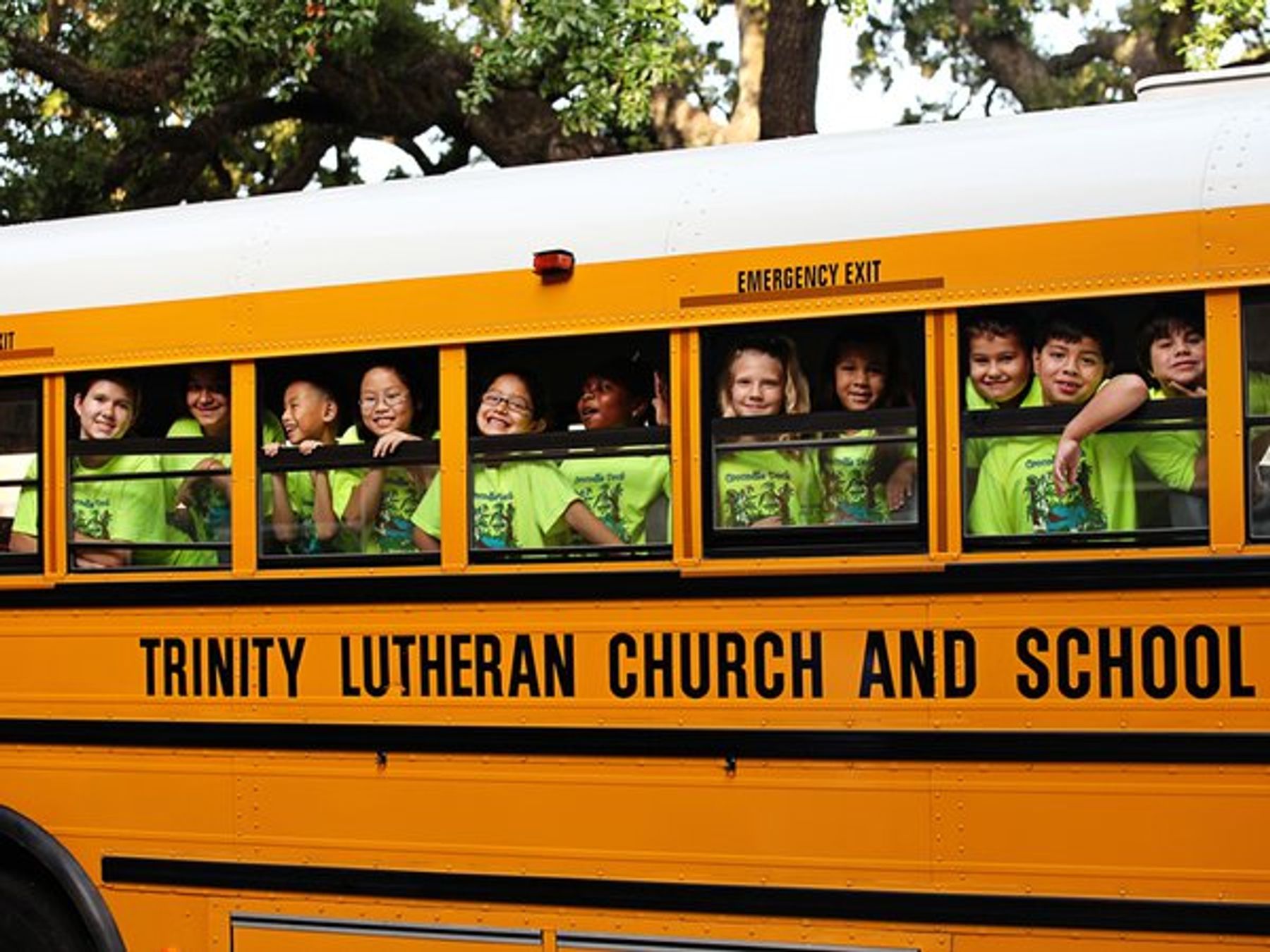Learn Central: A Diversity of Choice
Learn Central: The Inner Looper’s Guide to Finding the Right School
When Laura Schaefer, chair of the Department of Mechanical Engineering at Rice University and her husband, Andrew, a professor of computational and applied mathematics at Rice, moved to Houston from Pittsburgh two years ago, they were not unfamiliar with the city. Both had gone to Rice for their undergraduate degrees. So, they knew they wanted to live inside the city core; neither was interested in a commute from the suburbs.
“We valued a short commute a lot,” she says. The question then became where to send their children, a daughter, now 13, and a son, now 10, to school. The Schaefers wanted an environment that would challenge their children, as well as be close, geographically, to the university where they now live as magistrars in one of Rice’s 11 residential colleges. They decided on St. John’s School for their daughter and enrolled their son at Annunciation Orthodox School.
“We looked at a lot of options, took all the tests,” said Schaefer. “And we wound up something like 900 on the wait list for River Oaks Elementary School.” Schaefer readily admits that she and her husband, who both were educated in public schools, wrestled with the idea of sending their children to private schools. In the end, however, St. John’s and AOS were the perfect fit for their family.
Helping parents figure out that same kind of perfect fit is exactly the goal of Learn Central, a new initiative developed by Central Houston, Inc. to help parents evaluate the educational options that exist inside the loop to better determine the best fit for their children. Originally named the Living Central Education Initiative, Learn Central was created to implement the commitment of Central Houston to livability and improved access to quality education options within the central core of our city. A committee of neighborhood representatives, including residents of management districts, parents and educators from schools inside the loop came together to determine what information should be included about each school to provide facts for parents making the often-challenging decision about where to educate their children.
The result is a comprehensive awareness campaign of central city education options, including a website that will serve as a one-stop shop for families looking to compare schools and programs, get an idea of each school’s “personality,” learn more about a school’s organization and leadership, and determine which would be the best choice for their children.
There are 152 public, charter and private schools inside the loop, an almost dizzying number for any parent to contemplate. While Houston, like most cities, has public neighborhood elementary, middle and high schools where residents are automatically zoned, the city also offers myriad choices parents can make: dual-language immersion, visual and performing arts curriculum, health sciences, as well as gifted and talented courses, available via testing and lotteries. Private schools may be independent or religiously affiliated, which may appeal to parents, but there are entrance tests, tuition costs and financial aid to navigate. It’s enough to make any parent wonder where to begin.
“Where will my child go to school is the No. 1 question we get from parents,” says Samantha Holy, regional human resources director for Gensler. Her job is to help the company, which is located in Downtown, find and onboard top talent from around the country. She says that people coming from out of the city, and even out of state, understand that Houston has many advantages, including a great cost of living and endless options for arts, culture, sports and dining, but they don’t know much about the fourth-largest city’s education system. “Learn Central helps us remain competitive as an employment center,” she says.
Holy says that the initiative allows parents to see, in a very real way, what living inside the loop can be like. They may have already heard about the great museums, about how easy it is to get around, about new living options in Downtown that put them in the center of the action. Now, they can also see what schools are available to them, as well as information on how to visit, how to apply, and what’s made those schools great choices for other parents.
“The Houston Independent School District (HISD) has wonderful options,” says Holy. “There are magnet programs, there are great neighborhood schools. Learn Central lets parents see, ‘If I live in this neighborhood, this would be my child’s school.’ But it also lets them see these other options they may not have known about, and gives them a path to explore how to apply for those programs. And, in terms of the idea between sending a child to a public school or a private one, obviously a family’s individual values come into play, but Learn Central gives parents the tools to see the different schools out there and determine which would align most closely with what they’re looking for.”
KNOW YOUR CHILD, KNOW YOUR VALUES
While Learn Central is an excellent tool box for parents, experts say it’s exactly that: a tool. Educating your child is one of the most important decisions a parent can make, so knowing who your child is and what his or her needs are is a key factor in selecting a school.
“As an admissions director, I want parents to have all the data readily available for them,” says Ky Wilson, the director of admission for St. Stephen’s Episcopal School, a private Christian school that adheres to the Montessori method and serves grades K–8. “We want our families to determine if we are the right for them and if this program is best for their child.”
She says she champions Learn Central because it helps parents get a real picture of what a particular school is like. What are the demographics? What programs are offered? Do parents like the school for their children? All of these factors can be vital for parents considering the best school for their children.
“I counsel parents to ask themselves what their short- and long-term educational goals are,” says Wilson. “For instance, are they looking for a school for that will augment their religious beliefs? What are the individual needs of each child? I tell people, create a list of everything that’s important to you in terms of education, and prioritize it. Once they have that, Learn Central can help them select schools that match those values.”
Ruth López Turley, a professor of sociology at Rice University has two children enrolled in one of HISD’s dual-language Spanish schools. It was important to her that her children not just know and understand Spanish, but be bilingual. As a researcher whose work focuses on educational inequality, it was important to her that her children attend a public school.
“HISD has some schools that are among the best in the country,” she says. “Sometimes people automatically dismiss public schools, but that shows they haven’t done their homework. Our schools have so much to offer.” López Turley points out there is a distinct difference between the program her children are enrolled in and in language lessons that are available at other public and private schools. With many language programs, children are taught a foreign language as another class, for an hour or two each day or every week. With a dual-language program, students are taught in that foreign language.
“My children are learning from both native English and native Spanish speakers,” she says. “And they are in a school with a mix of students of different racial, ethnic and socioeconomic backgrounds. The program we selected for them not only allows for natural integration, it provides long-term exposure to Spanish. This kind of option isn’t available in a private school.”
López Turley knew that the program she and her husband selected would be best for both her children and her family. In addition to her desire that the children be bilingual, she was adamant about being a champion of public education. “We wanted a place where our children are exposed to so many different kinds of people, from different nationalities, different socioeconomic backgrounds and on and on,” she explains, noting that Houston’s diversity is one of its strengths.
“Your kids have to be exposed to the real world.” Through her own academic research, López Turley says that when children go to diverse schools, schools that are fully integrated, where both the children and parents mingle and work toward a common good, everyone benefits.
“There were two main points for me in the decision we made about our children’s education,” says López Turley. “First, I wanted to practice what I preach. I believe public schools are a societal good, and I believe we need to mix things up, so all of our children meet different kinds of people. But my second issue was that my first language is Spanish. And I wanted my kids to be fluent. I knew a program like this would be able to teach them in a way I couldn’t.”
Wilson says the process like the one López Turley and her husband, as well as the Schaefers made, to decide where to send their children is a vital component to the array of options parents have inside the city core. Parents should ask themselves about their own values and concerns. Everyone wants the best academic experience for their children, but it’s important, Wilson says, to know that that can mean different things for different children.
“Your child’s education will affect the whole household,” she says. “Some schools require more involvement from parents than others, whether financially or in terms of volunteering. How are you willing to integrate that into your lives? Does your child need a rigid environment, maybe one with uniforms and structured curriculum? Is your child more creative? All of those things need to be taken into consideration when selecting a school.”
Learn Central gives parents a place to consider those concepts. Parents can select public or private options, can look at schools by specific neighborhoods, can connect with other parents to hear what their experiences have been like.
“People pay attention when their peers are talking about something,” says López Turley, which is another reason she supports the effort of Learn Central. “It provides an independent source for parents that can help them determine the best fit for their child.”
FAMILY EXPERIENCES, DETAILED DATA
“When families relocate to Houston from someplace else, they want an idea of what their lives here will be like,” says Holy. “They want to move into neighborhoods where there will be people who have similar lifestyles, and they may be looking to recapture something here that they have where the currently live.”
For people moving to Houston from other countries, Europe in particular, Holy says that lifestyle takes on a cosmopolitan, urban vibe. That almost certainly means relocating inside the loop, as opposed to a longer commute from one of the suburbs surrounding the city, hardly surprising, says Holy, since many ex-pats don’t have driver’s licenses, since they didn’t need cars.
This sort of scenario makes Learn Central an asset for these families, showing them snapshots of different Houston neighborhoods (Montrose is different from the Heights, which is different from Downtown), and providing them with not only an idea of what life there can look like in the day-to-day, but also offering comprehensive information on school options available for their children.
“One thing to think about with a school is definitely the other parents,” says Wilson. “Are they people you can see yourself socializing with, working with on volunteer committees? Those parents will be influences on their children, who will go to school with yours, so having an understanding of who they are is essential in helping parents make an informed decision about school choice.”
Learn Central’s one-stop-shop helps parents to navigate the personalities of schools within the areas they’re considering. It also provides information about a particular neighborhood average commute time to a family’s place of work, something Holy says is a great advantage.
“Some people don’t want a one- or two-hour commute,” she says. “Learn Central gives a realistic portrait of our city. I think it really positions Houston in a better way to showcase all that we have to offer.”
Miah Arnold, a writer, has two children, a daughter Lila, who is 11 and entering 6th grade, and a son, Vishwa, who is 7 and about to be a second grader. She and her husband, Raj Mankad, recently returned to Houston after working in rural Georgia for a year. Both children attend Travis Elementary School. Mankad says that selecting a school for them was a paramount concern when they came back to Houston.
“It’s not easy,” he says of their process. “For several years of our lives, it seemed like every conversation with other parents came back to schools. It still does. One of the biggest challenges is that the situation is so dynamic. The possibilities and options keep changing. You could get your kid into certain excellent public elementary schools, like Roberts and Poe, through the magnet process until about two or three years ago. Now those schools get all or nearly all of their spots filled with children in their zone. Other schools that did not have many options for advanced classes in the past now do, like Hogg Middle School in the Heights, and have become big draws.”
He says also that parents have to identify what constitutes a “good” school. For some, it might be test scores; for others, it might be the overall atmosphere of the place. Those things mattered to Mankad and Arnold, for sure, but there was another factor they wanted to be sure their children had: diversity in their classrooms.
“Living in rural Georgia and that gave us a lot of perspective. Although there are plenty of things we don’t think are perfect about HISD — unhealthy food in the cafeteria and excessive standardized testing come to mind — there are many things to appreciate about Houston schools. For example, our children have a complex ethnic background that’s accepted and celebrated here. We don’t take that for granted.”
Arnold agrees. She works with a program called Writers in the Schools, which places working writers in public schools around Houston to offer classes and provide writing programs. That experience gave her an edge she knows other parents might now have. While they are mostly happy with their decision, there have been a couple of bumps. Lila is in the school’s GT (gifted and talented), and Arnold calls her a very academically driven girl. Vishwa is also very intelligent, but he didn’t test into the GT program because of some reading issues; he has dyslexia.
“The easy part is after the [school] choice is made and you watch your kids make their mark at the school you end up in,” she says. “The kids are most of the magic, and if you support them, they'll excel where they end up. I have loved the Travis community, and volunteer in it; but with my son not in the GT program I see the weakness that a school divided produces, especially in his confidence level. I'm not sure what the answer is.”
Currently, they’re trying to determine which middle school will be best for Lila; they are considering Hogg, Lanier or TH Rogers. Arnold said she might home school Vishwa next year, to help him grow his confidence in his abilities and realize his full potential. And, while Arnold understands that she can make these choices for her family because she has something of an inside perspective on her neighborhood’s schools, she knows other families may not.
“I think young families can get a good sense of what kinds of schools they want to check out, thanks to Learn Central,” she says. “They can get a sense of the personality of a school, the goals, the administration. I had the benefit of teaching in a lot of schools, but most people don't. Hearing stories about schools and principals and teachers and neighborhoods will be a great service. There are websites that rate schools by stars, but they don't ask as many questions as a person has. Learn Central will help people make more confident choices.”
THE BEST DECISION FOR YOUR CHILD
“There is no way to predict what a 5 year old will be like as a seventh grader,” says Wilson, who explains that she encourages parents to be open to the changing needs of their children as they continue their education journey. “Children change over time. And that’s ok.”
As parents notice those changes, whether it’s a child’s deeper dive into a particular subject, or maybe a stumbling block in a certain program, Learn Central can also be a place for parents to connect with other parents having similar issues – and discover what other educational opportunities might exist.
Wilson says half-jokingly that she hopes parents will be “courageous” about when and how they might change their minds in terms of what their children need, as often, without meaning to, parents can project their own successes and interests onto their children. But knowing how your child is growing and changing gives parents a solid perspective from which to work when determining how to made a school switch, whether it’s a natural break between elementary school to middle school or middle school to high school, or even just because a child may no longer be thriving in his or her current environment.
Schaefer says that her son will probably apply to St. John’s for his sixth grade year, as it’s a natural transition time. Certainly, she acknowledges the convenience of having both of her children in the same school. But she knows that each school provides each child with particular things.
“They are both very smart and curious and great students,” she says. “My daughter is very sporty, though, and one of the things she loves about St. John’s is the ability to be involved in athletics. David loves AOS, and as a family we’re impressed by the school’s commitment to charity and stewardship; it’s a great environment. So, for us, it’s still a win if we ultimately decide he’ll continue there through the eighth grade.”
Mankad and Arnold are also facing a natural transition, as they determine the best next school for Lila. “Our choice is between keeping her at Hogg, a school where her most influential teacher will be teaching but that has not yet proven itself academically in the way TH Rogers and Lanier have,” says Arnold. “But Hogg has a really dedicated staff and a large number of Travis families are attending -- it'd be a small school filled with a core group of her best friends, and an administration working hard to turn the school academically as schools like Wharton, Wilson, or Travis were turned in the last 15 years. TH Rogers is her pick because she's very academically gifted and she longs for intellectual challenges and she has heard all her life TH Rogers is the place for that.”
Holy points out to parents that there are multiple options for great schooling inside the loop, both public and private, making the city core an attractive place for families with children. And López Turley says the biggest myth she encounters is that Houston’s public schools aren’t as good as either private schools or the public schools in the suburbs. “People really shouldn’t automatically dismiss them,” she says. “They can look up the school profiles, and see for themselves what the test scores and programs are, what credentials the teachers have. All that information is available.”
And Learn Central puts in all in one place. But, because parents often listen to other parents, consider López Turley’s commitment to finding a dual-language program for her children and her desire that they be bilingual. “They are fluent in Spanish,” she says. “And when we travel to Mexico or anywhere else around the world, they jump right into this language, they play with other kids. It's exactly what I envisioned."
LEARN CENTRAL BASICS
- Schools available: 152
- Super Neighborhoods represented: 29
- Search by individual school, neighborhood, school type (public, private,)
- Detailed information on what kinds of questions parents should ask, how to enroll and a glossary of useful terms
- Individual descriptions of every school inside the loop, along with maps, school make-up and programs offered
- Snapshots of each neighborhood, including school listings, homes for sale, a commute calculator and description of the community
Mentioned in this Post
The Houston Independent School District (HISD)
4400 West 18th St





